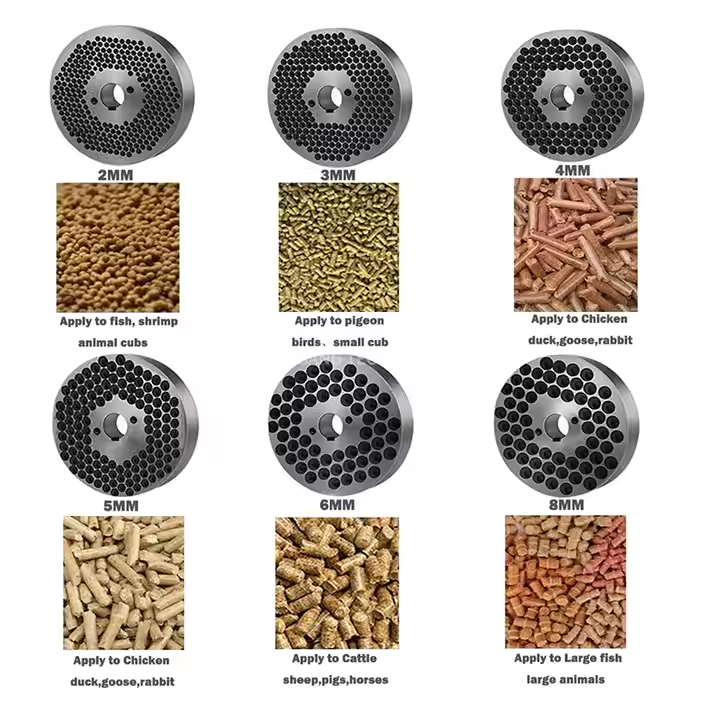pelleting machine price in nigeria ,animal feed pellet machine
Why You Need to Make Feed Pellets for Your Poultry and Livestock
May 6, 2025
Why You Need to Make Feed Pellets for Your Poultry and Livestock
Research and practical experience have shown that feed pellets are an excellent diet for poultry and livestock. Here’s why:
- Feed pellets prevent animals from being picky eaters.
- They stop feed from automatically separating into different components.
- They offer a high feed return rate.
- They have good flowability.
- They are free from salmonella.

The Quality of Feed Pellets
High-quality feed pellets can withstand repeated handling without breaking apart or producing too much dust during bagging, transportation, storage, and movement in feed lines.
Pellet quality is measured using the Pellet Durability Index (PDI). This is tested with a tumbling can device:
- First, the sample feed pellets are sieved to remove fine particles.
- Then, they are tumbled in the device for a set time.
- After tumbling, the pellets are sieved again to remove small particles.
- The remaining intact pellets are weighed to determine PDI.
How to Calculate PDI
Other equipment, such as Holman particle detectors and wood detectors, can also be used to test pellet durability.
Factors Affecting Feed Pellet Quality
1. Feed Formula
Some ingredients improve pellet quality, while others weaken it. Corn and soybean-based diets are not ideal for achieving the best pellet quality.
- Wheat (high in gluten and hemicellulose) improves PDI when added to feed.
- Oats can replace corn to enhance pellet quality.
- The ranking of grains by their positive effect on pellet quality (best to worst): oats > wheat > barley > corn > sorghum.
Starch gelatinization is crucial for pellet quality, but recent studies show protein has an even greater impact.
- Adding oil to feed reduces pellet quality because it blocks steam penetration and decreases starch gelatinization. (Oil is usually sprayed on fish or pet feed after pelleting.)
- Binders (water, lignosulfonates, gelatin, etc.) and surfactants improve pellet quality, yield, and reduce energy use.
Sample Cattle Feed Formula (Reference Only)
| Feed Ingredient | Store Cattle (>40kg) | Young Dairy Cattle (>250kg) |
|---|---|---|
| Maize | 65% | 60% |
| Soybean meal | 5% | 10% |
| Cottonseed meal | 15% | 20% |
| Wheat bran | 11.5% | 5.5% |
| Bone powder | 1% | 1.5% |
| Salt | 1% | 1% |
| Soda powder | 1% | 1% |
| Flavoring agent | 0.5% | 1% |
Feed Pellet Quality Factor (FPQF) This tool predicts pellet quality in a feed formula:
- Each ingredient has a Pellet Quality Factor (PQF) (0 = poor, 10 = excellent).
- FPQF = (PQF × ingredient %).
- FPQF < 4.7 = poor pellet quality.
- FPQF > 4.7 = good pellet quality.

2. Particle Size of Feed Ingredients
Smaller particles improve pellet quality, but excessive grinding wastes energy and harms livestock digestion. Coarse grinding reduces starch gelatinization (needed for strong pellets).
3. Steam Conditioning
Steam heats and moistens feed powder, helping starch gelatinize, binding particles, semi-digesting feed, and killing pathogens.
- 80°C conditioning produces high-quality pellets.
- Minimum 30 seconds in the conditioner improves durability.
- Longer conditioning (3-4 min) increases pellet viscosity.
4. Ring Die & Press Roller Specifications
Pellets form when hot powder is pressed through a ring die.
- Thicker dies (60mm > 50mm > 40mm) increase friction, improving gelatinization.
- Smaller die holes (3mm > 5mm) also help.
- Adjusting roller distance (0.1mm to 2mm) boosts durability.
5. Cooling Process
Fresh pellets are 70-90°C, 15-17% humidity. They must be cooled to:
- 8°C above room temperature.
- 12% humidity.
- Too fast cooling makes pellets brittle.
- Too slow cooling dries pellets, causing wear and poor taste.
For high-quality feed pellets, trust MAIKONG. Contact us: WS/TEL: 0086191-549010-65
Contact us online by Whatsapp:

